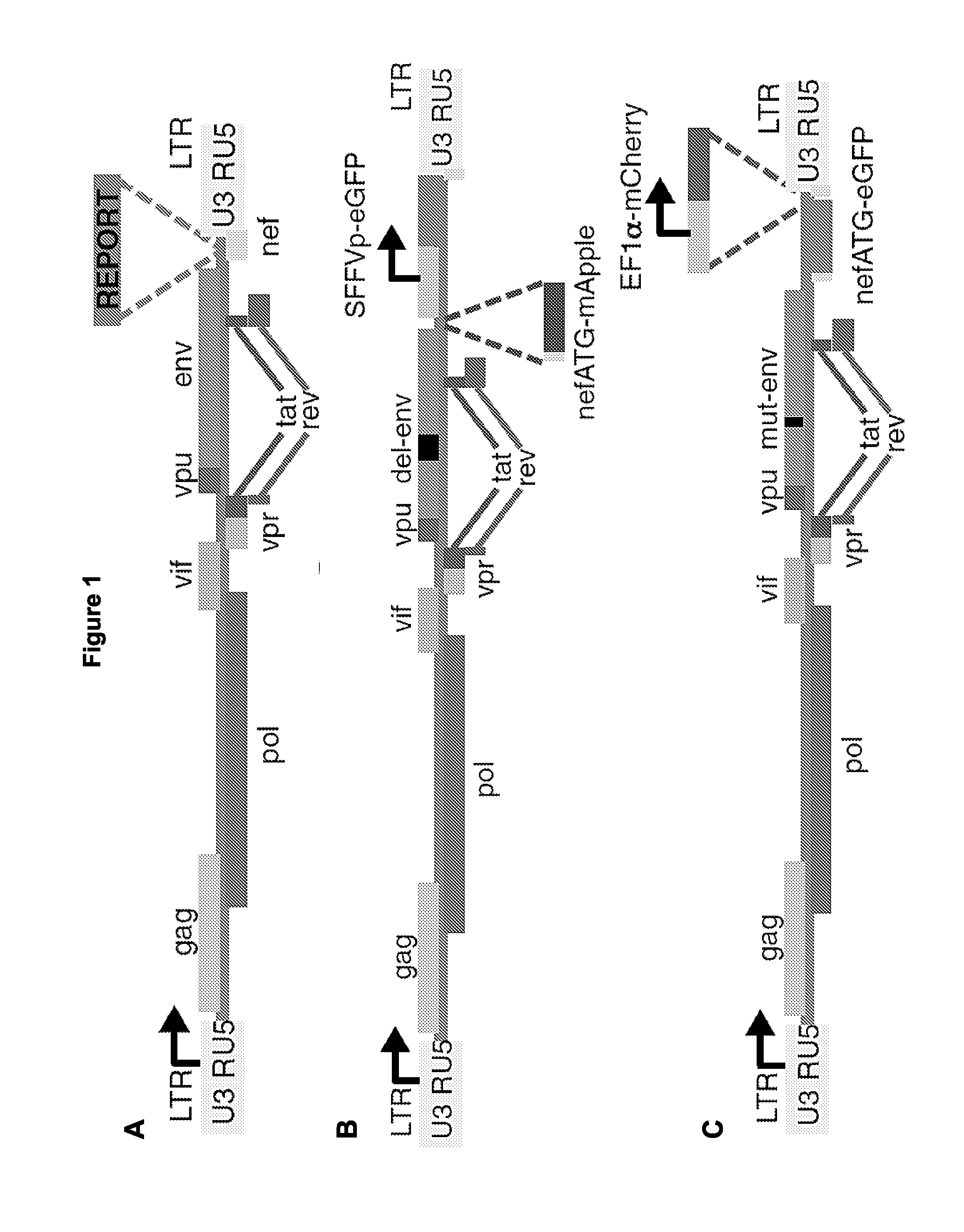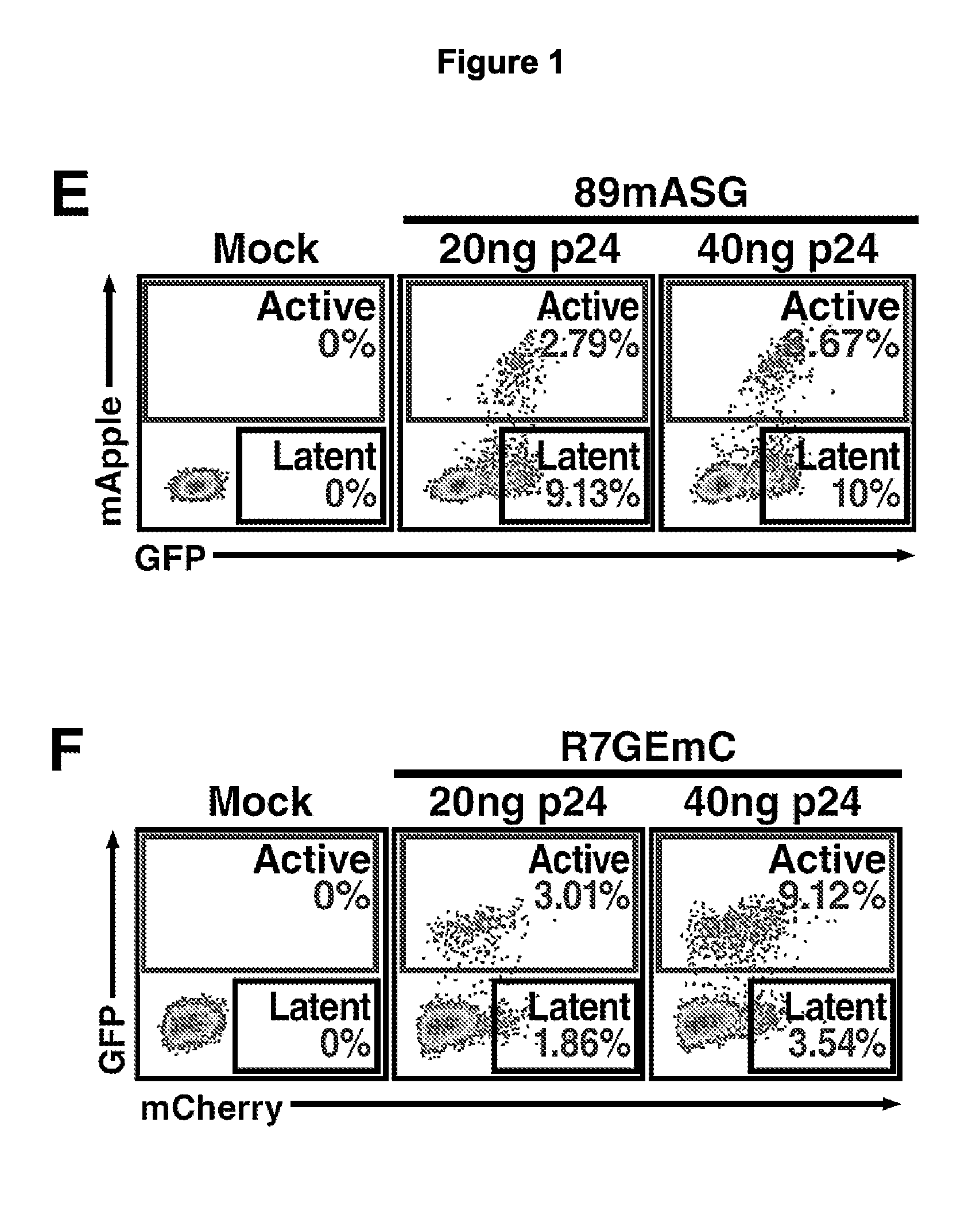Compositions and methods for identifying latently infected cells
a technology of latent infection and composition, applied in the direction of viruses/bacteriophages, biocide, animal repellents, etc., can solve the problems of virus reappearance rapid, complete suppression of viral replication, and inability to clear hiv infection
- Summary
- Abstract
- Description
- Claims
- Application Information
AI Technical Summary
Benefits of technology
Problems solved by technology
Method used
Image
Examples
example 1
Dual-Color Viruses Allow Direct Labeling of Live HIV Latently Infected Cells
[0443]To identify latently infected cells prior to reactivation, two novel HIV-1-based lentiviral constructs were designed in which LTR expression is monitored by production of a fluorescent protein while another independent transcriptional unit expresses a spectrally distinct fluorescent protein under the control of an independent promoter. To construct the first clone, the 89.6 / DNE / SFG reporter was used in which nef is replaced by a Spleen Focus Forming Virus (SFFV)-promoter-driven enhanced green fluorescent protein (EGFP; FIG. 1B). This clone has an env deletion, which limits infection to a single round. A sequence- and ligation-independent cloning (SLIC) strategy was used to reconstitute the nef ATG sequence and replace the remainder of the nef open reading frame with the sequence of a red fluorescent protein, mApple (Shaner et al, Nat Methods. 2008 June; 5(6):545-51, which is hereby incorporated by refe...
example 2
Cells Enriched for HIV-Promoter Independent Expression Contain an HIV Genome that can be Reactivated
[0448]To estimate the fraction of single-positive cells that can be reactivated in terms of HIV expression, the purified cells were treated with drugs reported to reactivate latent HIV, including tumor necrosis factor (TNF)-α (Jordan et al., EMBO J. 2003 Apr. 15; 22(8):1868-77); prostratin, a protein kinase C (PKC) activator (Williams et al., J Biol Chem. 2004 Oct. 1; 279(40), which is hereby incorporated by reference in its entirety); and suberoylanilide hydroxamic acid (SAHA) (Contreras et al., J Biol. Chem. 2009 Mar. 13; 284(11):6782-9, which is hereby incorporated by reference in its entirety), a non-selective histone deacetylase (HDAC) inhibitor. All drugs increased expression of HIV promoter-dependent reporter (FIG. 2A, B top, C, D). Testing of drug combinations that act on different pathways showed maximal reactivation in response to combined SAHA and prostratin treatment, as p...
example 3
Two-Color HIV Latency Model can be Used for High-Throughput Screening
[0452]Next, the power of this novel HIV latency experimental system to identify novel drugs that reactivate latent HIV was tested in a high-throughput format. 5,000 GFP-only-positive cells of 89mASG-infected Jurkat T cells were plated in each well of 384-well plates, coated with a protein solution (Cell-tak) to induce cell attachment and efficient imaging. Preliminary experiments indicated that this protocol yielded the lowest background reactivation and the highest dynamic range (up to 75% cell reactivation with the most effective drug combinations). Cells were treated with 1,120 individual compounds from the Tocriscreen biologically active compound library at 30 μM for 24 hr (drug combinations are shown in FIG. 2A, B) before they were stained with Hoechst. Next, each well was imaged, and total red fluorescence (indicative of reactivated virus) and total blue fluorescence (Hoechst-stained nuclei) were quantified (...
PUM
| Property | Measurement | Unit |
|---|---|---|
| Fluorescence | aaaaa | aaaaa |
Abstract
Description
Claims
Application Information
 Login to View More
Login to View More - R&D
- Intellectual Property
- Life Sciences
- Materials
- Tech Scout
- Unparalleled Data Quality
- Higher Quality Content
- 60% Fewer Hallucinations
Browse by: Latest US Patents, China's latest patents, Technical Efficacy Thesaurus, Application Domain, Technology Topic, Popular Technical Reports.
© 2025 PatSnap. All rights reserved.Legal|Privacy policy|Modern Slavery Act Transparency Statement|Sitemap|About US| Contact US: help@patsnap.com



